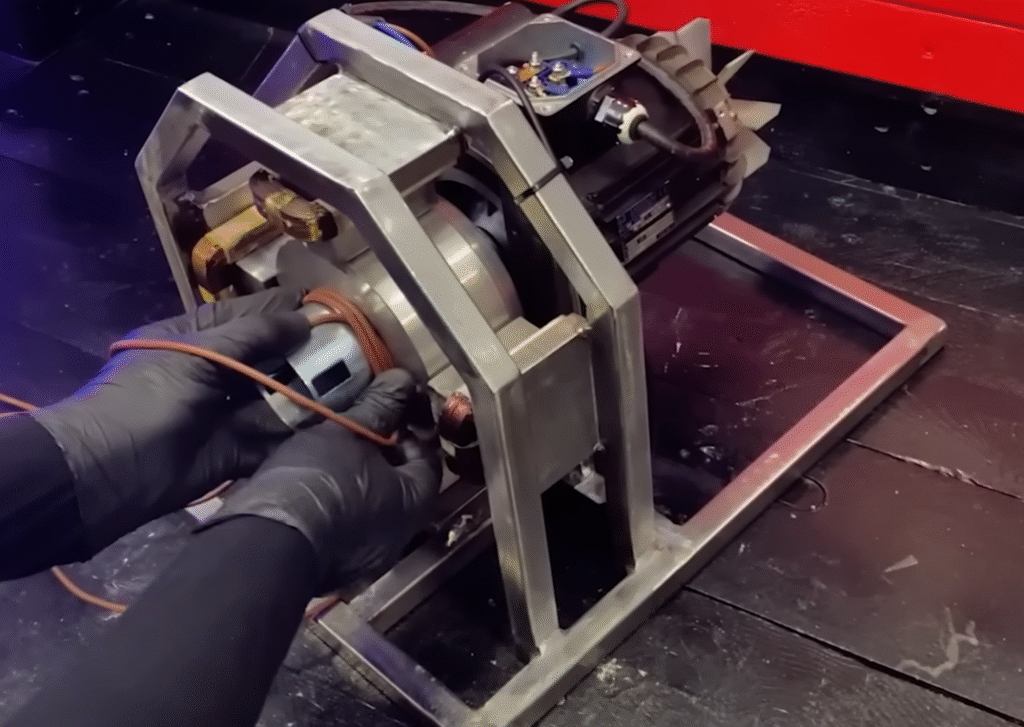
This machine defies logic. No fuel, no solar panels, no wind turbines. Just movement, silent and relentless.
In the shadow of history, one name echoes louder than the rest. Nikola Tesla. A man obsessed with giving the world free energy.
They silenced him. But what if someone, somewhere, finally cracked the code? A hidden invention, rediscovered. A device born in a workshop, not a lab.Today, we uncover the Liberty Engine 2.0. An electromagnetic system that might just rewrite the rules of power forever. This isn’t science fiction. It’s here.
And it’s working. Tesla’s forgotten vision. Nikola Tesla believed that energy should be as free as the air we breathe.
In the early 1900s, he dreamed of a global system where electricity could be transmitted wirelessly. No wires, no bills, no limits. His experiments at Wardenclyffe Tower weren’t just about communication.
They were about energy liberation. But the dream died quietly. Investors pulled out.
Powerful forces feared what free electricity could do to their profit margins. Tesla was labeled a mad scientist. His tower was demolished, and his notes vanished into obscurity.
Conspiracy theories suggest those blueprints held the key to unlimited power, buried by those with too much to lose. Still, whispers never stopped. Tinkerers, engineers, and visionaries across generations have tried to piece together what Tesla might have discovered.
And now a small team believes they’ve built something in his spirit. The Liberty Engine 2.0 isn’t a wireless tower, but its goal is the same. Free, self-sustaining energy that doesn’t rely on the grid.
It doesn’t claim to break the laws of physics, but it dares to question what’s possible within them. And in doing so, it pulls back the curtain on a new kind of electricity. One rooted not in fantasy, but in carefully engineered electromagnetic motion.
The Liberty Engine 2.0. What it is. It doesn’t look like much at first. A few coils, a rotor, magnets, some wires.
But the Liberty Engine 2.0 isn’t trying to impress with appearance. It’s built to perform. At its core, this is a generator designed to sustain itself.
Once it starts, it keeps spinning. Once it spins, it keeps producing electricity. The system relies on a principle called electromagnetic induction.
But instead of using fuel, solar panels, or batteries, it uses motion, specifically the motion of a rotor embedded with N52-grade neodymium magnets. These are among the most powerful permanent magnets in the world. When they spin past tightly wound microwave transformer coils, they generate alternating current, AC electricity.
Just like in any large-scale power plant. The difference? This one fits in a garage. The rotor itself is crafted from a special alloy of aluminum and silver.
Why? To reduce eddy currents, which are tiny energy losses that occur when metals interact with magnetic fields. By minimizing those losses, the team boosts overall efficiency and keeps the system running smoother, longer. The frame is custom built.
Each coil is locked into a resin casing. The rotor is perfectly centered. Every slot and support is carefully balanced to avoid vibration, which can disrupt the delicate energy flow.
Even the startup mechanism is old school, a simple pull cord. No batteries, no switches, just raw kinetic energy. Once the engine starts, it spins at a constant 1,400 revolutions per minute, generating a steady 230 volts AC, the same voltage used in most homes across Europe and parts of Asia.
Its claimed maximum output? A staggering 20,000 watts. Enough to run computers, tools, even a water pump. And it doesn’t stop.
As long as the rotor keeps turning, the electricity flows. What’s most shocking isn’t the hardware. It’s the simplicity.

No hidden chambers, no exotic materials, just clever engineering and precise alignment. It’s a design that seems too good to be true until you see it running. And that’s exactly what the next part of the story reveals.
How it works. The technology behind it. So how does a machine keep generating electricity without external power? It’s not magic.
It’s a feedback loop built on magnetic force, motion, and timing. The Liberty engine. 2.0 begins with a manual pull start, like an old lawnmower.
When you pull the cord, you’re turning the rotor, a circular core embedded with neodymium magnets. As the rotor spins, these magnets pass close to the surrounding microwave transformer coils, which were salvaged from standard appliances and rewound for precision. When a magnet moves near a coil, it induces an electrical current.This is Faraday’s law in action. A changing magnetic field inside a coil produces voltage. That voltage flows into the engine’s outlets and, crucially, back into the motor, which now takes over the job of keeping the rotor spinning.
This is the feedback loop. The initial pull just kick-starts the process. Once the system is generating enough power, it sustains itself, drawing energy from its own rotation and continuing to produce output power as long as everything stays in motion.
Now here’s where the genius lies. They built the rotor using aluminum-silver alloy to eliminate most Foucault or Eddy currents, those pesky loops of electricity that sap energy and create heat. By reducing internal resistance and avoiding energy bleed, the engine preserves almost all of its generated power.
They also eliminated pulleys and belts, which are common in traditional generators. No friction from rubber or gears, just direct-drive mechanics. Less friction means less energy wasted.
Every component was chosen with one goal, self-sufficiency. The team also claims there are no hidden batteries, none in the base, none in the sockets. To prove it, they filmed the device being disassembled on camera with no cuts or edits.
Every wire, every coil, every part laid bare. You’ll find that link in the description. But here’s the most impressive part.
The engine isn’t just running LEDs or little fans. It’s powering Hydra devices, IMAX, drills, grinders, and water pumps without interruption. All off-grid.
No external wires, just the engine. While some engineers might scoff, the device isn’t pretending to be a perpetual motion machine. It doesn’t violate physics.
It simply exploits magnetic momentum, low resistance, and smart wiring to stay alive. It’s not infinite energy. But it’s the closest thing we’ve seen to independent energy.
And it’s already working. Real-world tests and performance claims are easy. Proof is harder.
But the Liberty Engine 2.0 doesn’t just talk. It performs. In one of their first outdoor tests, the team set up the generator in an isolated location, far from any electrical grid.
No wires running underground. No backup sources. Just the engine, a set of power tools, and a camera rolling with no edits.
The test lineup included an IMAX 27-inch, a drill, a grinder, and a water pump. Not just lightweight gadgets, but real power-hungry devices. One by one, they plugged each in, and the engine handled them with ease. No flickering lights. No voltage drops. Just smooth, uninterrupted performance. Even more impressive? The output remained steady at 230 volts, and the rotor kept spinning at a constant 1,400 RPM. That’s the sweet spot. It means the system was generating enough electricity to power multiple devices and maintain its own momentum.
What’s more, the engine didn’t overheat. Thanks to the custom rotor alloy and resin-sealed coils, heat was minimal and efficiency stayed high. The noise was low.
No clattering belts or whining motors. Just a faint hum of movement. To silence doubters, the team offered a full, unedited teardown video.
They disassembled the engine piece by piece, showing exactly what’s inside. No hidden batteries. No tricks.
It’s all on camera. While some still question how long it can run without needing maintenance or whether it’s scalable for homes, the early tests are clear this isn’t just theory. It’s a working prototype delivering real, usable power.
And if this is just version 2.0, the future might be even more electrifying. The Liberty Engine 2.0 isn’t perfect. It’s still a prototype.
But it’s a spark, one that could ignite a much bigger movement. Imagine a world where every home could generate its own power. No blackouts.
No bills. No dependence on unstable grids. Just clean, quiet, sustainable electricity created on demand.
For off-grid communities, disaster zones, or even space missions, a system like this could change everything. But innovation like this doesn’t come easy. It needs support.
It needs people willing to look beyond what’s approved and start asking, what if there’s another way? The team behind Liberty Engine 2.0 is already exploring better alloys, stronger magnets, and more compact builds. With open access, shared knowledge, and real-world testing, this concept could evolve into a household reality. And let’s not forget the bigger picture.This isn’t just about saving money. It’s about freedom. Freedom from power monopolies.Freedom from fossil fuels. Freedom to imagine a future where energy is abundant, clean, and yours to control. The question isn’t whether this works.It’s whether we’re ready to let it. What you’ve seen today is more than a machine. It’s a message.A reminder that the boundaries of science are not fixed. They’re waiting to be moved. The Liberty Engine 2.0 is just one attempt, but it carries the spirit of every inventor who ever dared to dream beyond the system.
Whether it becomes a revolution or just a spark, it invites us to question, to explore, and to create. If free energy is possible, then the future won’t be built in factories. It’ll be built in garages by people who believe in the impossible.


